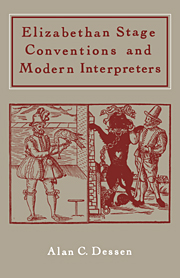Book contents
- Frontmatter
- Contents
- Preface
- Note on texts and old spelling
- 1 The arrow in Nessus: Elizabethan clues and modern detectives
- 2 Interpreting stage directions
- 3 The logic of ‘this’ on the open stage
- 4 Elizabethan darkness and modern lighting
- 5 The logic of ‘place’ and locale
- 6 The logic of stage violence
- 7 Theatrical metaphor: seeing and not-seeing
- 8 Conclusion: Elizabethan playscripts and modern interpreters
- Notes
- List of plays and editions
- Index
3 - The logic of ‘this’ on the open stage
Published online by Cambridge University Press: 22 September 2009
- Frontmatter
- Contents
- Preface
- Note on texts and old spelling
- 1 The arrow in Nessus: Elizabethan clues and modern detectives
- 2 Interpreting stage directions
- 3 The logic of ‘this’ on the open stage
- 4 Elizabethan darkness and modern lighting
- 5 The logic of ‘place’ and locale
- 6 The logic of stage violence
- 7 Theatrical metaphor: seeing and not-seeing
- 8 Conclusion: Elizabethan playscripts and modern interpreters
- Notes
- List of plays and editions
- Index
Summary
His gesture imports it
(Othello, iv. i. 135–6)Before dealing with a series of problems linking stage directions with differing logics of interpretation, let me focus upon a phenomenon that can bedevil the interpreter of any playscript but, given the absence of clear signals, is especially perplexing in many scenes and passages in the age of Shakespeare. I am referring to the widespread use of gestic terms like this, there, here, yon, and thus where the meaning of a line or phrase is (presumably) to be completed or fulfilled by a motion or action from the speaker. Indeed, one such passage has achieved a notoriety of its own. Thus, to call attention to the difference between scripts and texts, the ‘stage-centred critic’ (to borrow a term from J. L. Styan) regularly cites Polonius' line: ‘Take this from this, if this be otherwise’ (II. ii. 156) where the first this refers to ‘head,’ the second to ‘shoulders,’ and the third to ‘this situation.’ Initially puzzling to a reader, the line makes immediate sense to a spectator attending both the words and the gestures of an actor. Equally obvious if less famous is Achilles' appraisal of Hector: ‘Tell me, you heavens, in which part of his body / Shall I destroy him, whether there, or there, or there?’ (IV. V. 241–2).
- Type
- Chapter
- Information
- Elizabethan Stage Conventions and Modern Interpreters , pp. 53 - 69Publisher: Cambridge University PressPrint publication year: 1984



